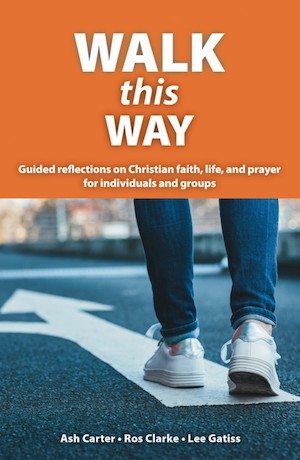 My friends at Church Society were kind enough to send me an advance copy of their latest book, Walk This Way, which has been launched today.
My friends at Church Society were kind enough to send me an advance copy of their latest book, Walk This Way, which has been launched today.
If the Christian life can be described as a walk, and if the Bible is our map, then how can a new believer get their bearings? One approach, which has been tried and tested for centuries, is to look at the Apostles’ Creed, the Ten Commandments, and the Lord’s Prayer, treating them as ‘signposts along the way’ (p. 7). Walk This Way revives that approach for our own day and age, and serves as an excellent introduction to the fundamentals of Christian faith, life, and prayer. There is definitely an Anglican (even Church of England) flavour to the book, but it could easily be used by others who are appreciative of the historic Anglican tradition.
What might be the advantages of the approach taken in Walk This Way? First, it is an excellent idea to give attention to those three aspects of Christian discipleship: what we believe, how we should live, and how we should pray (along with a fourth section on the church and sacraments). Second, by structuring it around key liturgical texts, there should be plenty of connections between the book and what the reader experiences week by week in church services. (Of course, not every church recites all of those texts every week, but hopefully they are all used at least occasionally.) Third, it emphasises the connections with the church throughout history, not least with the Book of Common Prayer’s own Catechism. (Church Society is not alone in promoting this sort of approach: similar concerns are reflected in the Church of England’s own Pilgrim course, as explained by Steven Croft, Bishop of Oxford.)
The bulk of the book is divided into short chapters (3-5 pages each): 13 on the Creed, 11 on the Commandments (because the first chapter in each section is an introduction), and 9 on the Lord’s Prayer. Each chapter begins with the relevant phrase (or commandment) and a short passage of Scripture, and concludes with some questions for reflection and a prayer.
First, Lee Gatiss, Director of Church Society, walks us through the Apostles’ Creed, in a highly engaging and accessible manner. This is an outstanding introduction to the basics of the Christian faith. My only slight niggle is that, if readers are to be encouraged to memorise the Creed (p. 13), then it seems strange to use the somewhat obscure version in Church Society’s An English Prayer Book.
Second, Ros Clarke, Associate Director of Church Society, takes us through the Ten Commandments. Again, this is accessible and practical, and provides an excellent starting-point for thinking about what it means to live the Christian life. The discussion of each commandment is structured around the ‘threefold use of the law’: as a mirror, a deterrent, and a standard. On balance, I think I found this way of structuring it more puzzling than helpful – the distinctions are not always clear, and the three sections come across more like three facets of the third use – but that doesn’t detract significantly from the content of the chapters.
Third, Ash Carter, Rector of Kirk Ella (St Andrew) and Willerby in Hull, takes us through the Lord’s Prayer. Again, this is very accessible and engaging. Helpfully, in this case, the phrases printed at the top of each chapter do correspond to the modern version of the Lord’s Prayer used in the Church of England, so this will be useful for memorisation.
The fourth section is about The Church and Sacraments, with Lee Gatiss writing on baptism and the Lord’s Supper, and Ash Carter writing on the church. The format is the same as before, but the chapters are longer (11-14 pages each). The chapter on baptism could, I think, have benefited from some attention to the horizontal aspects of baptism as an outward sign (how your baptism is relevant to me), and the discussion of covenant theology and infant baptism might be challenging for a new believer. But, apart from that, the chapter is excellent, as is the chapter on the Lord’s Supper. The chapter on the church focuses on what ‘church’ means (local, universal, and how to identify a true church), but I wonder whether it would have been better to focus on what church means (family, fellowship, discipleship, mission).
The book concludes with an updated version of a nineteenth century catechism based on the Thirty-nine Articles. This is a valuable resource, though I suspect most readers will decide not to spend long studying it.
How might I use this book? I’m in my first year of curacy in the Church of England, and don’t have a lot of experience with confirmation courses and the like, but I could certainly imagine putting this book to use in such a context, or working through the chapters one-to-one with a new believer, or with someone who needed a firmer grounding in the faith. The sections are self-contained, and could be used in isolation, or combined in creative ways (for example, weekly sessions, each discussing something about the Christian faith, something about the Christian life, and something about prayer). But anyone would benefit from reading this book, even as a refresher for a long-standing Christian faith.